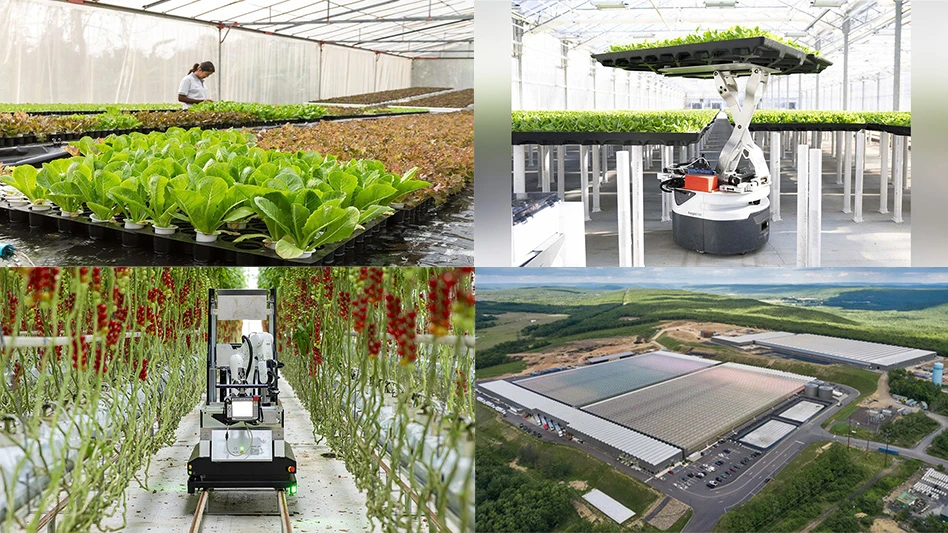
Whether or not people are actually eating better these days is certainly a debatable topic. But from a marketing and shopping perspective, the “healthification” of our food and how we eat is in full force. If you grow herbs and edibles, chances are you’ve seen a healthy (no pun intended) boost in sales of both over the past few years. When it comes to herbs, customers are looking for fresh, organic and local options at the grocery store and unusual varieties at the garden center for their home gardens. These trends spell opportunity for growers investing in culinary herb plant production.
Rain or shine
Despite sunny profit forecasts for edibles, weather has had an impact on sales to independent garden centers (IGCs) for some growers, including Nortex Wholesale Nursery in Texas. Nortex, the grower of Blue Label Herbs, faults intense rain and flooding the last two springs as the cause of “sideways” sales of herbs to local garden centers since 2014. While IGCs have traditionally been reliable customers for Blue Label Herbs, the weather pressure has exposed some growth opportunities with alternative customer groups. According to Nortex’s vice president, Aaron Pinkus, stormy weather hasn’t put a damper on sales to grocery stores. In fact, their sales to grocery stores have grown significantly. In an industry so impacted by changing Mother Nature, finding new weatherproof sales channels can be a boon.
What’s behind the growing success of grocery store herb sales? One major factor, says Pinkus, is relevancy marketing. “I believe the social media foodie culture is a large proponent of the continued success of herbs in the grocery stores, and I expect to see new and innovative products from Blue Label Herbs in the near future,” he says.
Keep it clean
How you grow your herbs is quickly becoming as important as which herbs you grow. Consumers are getting more focused on avoiding chemicals in their foods and paying attention to organic labeling. With new pesticide bans taking center stage in the media, your retail customers may face pressure from their customers to provide chemical-free edibles.
Going organic and achieving their USDA Certified Organic status has also had a significant positive impact on sales of Blue Label Herbs. Nortex has seen a “big” uptick in demand for its organic herb plants, especially from grocery stores and their customers.
When it comes to production challenges, Pinkus hasn’t run into too many with growing all of Nortex’s herbs organically. Since becoming certified, their production success has depended on adhering to a “very strict” beneficial insect pest control program. Pinkus notes that monitoring soil conditions closely is also a must. With a keen focus on those two factors, they’ve found their stride and don’t anticipate many future production challenges.

Keep it clear
Customers today don’t just expect your marketing to be relevant to their lifestyle and emotions — they expect you to be transparent and authentic. In addition to adopting cleaner methods for growing your herbs, you’ll also need to commit to communicating the story of how you grow them. Being upfront and honest about what inputs you’re using on your plants is key, whether the crops are for human consumption or for pollinator and wildlife support. That means you have to be much more strategic about how you use your packaging and labeling; they aren’t just for shipping or identification anymore, they also provide the customer with education and an insurance policy.
Shake it up
Changing palettes are another driving factor behind growing herb sales. As customers embrace more ethnic foods and new flavors, they’re willing to try more adventurous or unusual seasonings. So while basic favorites such as basil, cilantro, parsley, sage, rosemary and thyme still dominate herb sales, kitchen adventure seekers also want to add something more unique to their plates.
Adding variety and unusual herbs to the Blue Label Herbs line is yet another strategy that’s helped Nortex expand their grocery store sales. “Home cooks seem to enjoy experimenting with the many different varieties they never knew were available,” says Pinkus.
Fine tune your selection
American customers are also becoming more familiar with fines herbes, which are combinations of specific herbs essential to fine French cooking. The pinnacle of fines herbes is the combination of parsley, chives, tarragon and chervil. While chervil hasn’t traditionally been as popular as the other basic herbs in the combination, its familiarity is growing and you should consider adding it to your mix. In fact, why not offer this combination of fines herbes as a package deal to your customers? It would be a great marketing tool for both grocery store and garden center customers.
Many gardeners struggle with growing traditional celery, but have a much easier time with cutting celery. Consider offering up this variety in your selection as an alternative. Same goes for Lovage — most customers simply don’t know what to do with it. Lavender is hugely popular right now as a flavoring in all sorts of recipes. Salad burnet gives salads a unique flavor bump, and Shiso is hot on the tails of basil.
Reboot
Even the basics are getting upgrades. Basil isn’t just basil anymore. Customers want Thai, citrus and cinnamon-flavored basil varieties, as well as purple and red-colored plants. Dill is en vogue again, specifically for its use in fermentations and pickles. One really can’t have enough dill for such endeavors. Borage blooms are showing up all over the place, from salads to cocktails. The fact that it’s a great garden ornamental makes it easy to market as a dual purpose foodscape plant.
#GrowYourOwn
Who’s buying the herbs these days and how will they influence your bottom line in the future? That’s an interesting question. While older customers, who are likely to be more experienced cooks, are probably still your best customer for herb plants and fresh herbs in the produce aisle and may be driving the boost in sales at grocery stores, very soon you’ll have no choice but to rely on the upcoming generations’ buying potential. This situation offers up a double-edged sword: There are a lot of Millennials and they will offer a lot of buying power, but in general they’re not doing a lot of cooking. With home economics offerings dwindling in schools in recent years, many young people haven’t been exposed to cooking classes.
Many younger consumers are more likely to turn to the take out menu than to pick up a skillet.

Fresh moves
Perhaps it’s that very feeling of independence-inadequacy that’s driving the growing interest in modern homesteading, or self-reliance. Growing one’s own food and herbs, canning, pickling, fermenting and herbal infusions couldn’t be hotter. Consumers are desperately reaching for that feeling of control. Tap into that emotion with your herb and edibles marketing, and you’ll most likely hit nerves and wallets.
While there may be some real culinary learning-curve challenges facing younger consumers, Pinkus feels that ultimately their values will spell blue skies for Blue Label Herb sales. “The whole fresh and healthy food movement is driven by a generation that is likely to sustain their ideals for decades,” he says. Ultimately, it’s our job in the green industry to help them feel confident using our products so they have success and come back for more.
The whole fresh and healthy food movement is driven by a generation that is likely to sustain their ideals for decades. - Aaron Pinkus, vice president at Nortex Wholesale Nursery
New markets
It’s a logical conclusion that if the up-and-coming customer base is paying for other people to cook for them, that restaurants are still a growing customer base for herb plants and fresh cut herbs. And that’s been just the case for many fresh herb growers. But, many restaurants have picked up on the hyper-local growing movement and are bringing their fresh herb production in-house with their own gardens.
So where do growers turn next? Many consumers are now turning to “recipe box” services to try to wean themselves off of restaurant fare and develop some basic cooking skills. These deconstructed meal-to-door services are popping up everywhere and could be a great new marketplace for growers offering fresh-cut herbs. Once these consumers get a taste for certain herbs included in their recipes, they could be persuaded to want to learn how to grow such herbs at home, be it in an indoor or outdoor garden.

Explore the August 2016 Issue
Check out more from this issue and find your next story to read.
Latest from Produce Grower
- Cox Farms partners with Feeding America to tackle food insecurity
- Ethical labor practices supported by third-party certification programs
- Spotlight on strawberry production
- Relationship building
- Growing small to trial leafy greens
- IFPA expands team, launches strategic plan
- Downy mildew
- Thought Leaders to Share Insights at Clemson FRESH Food, Packaging & Sustainability Summit





